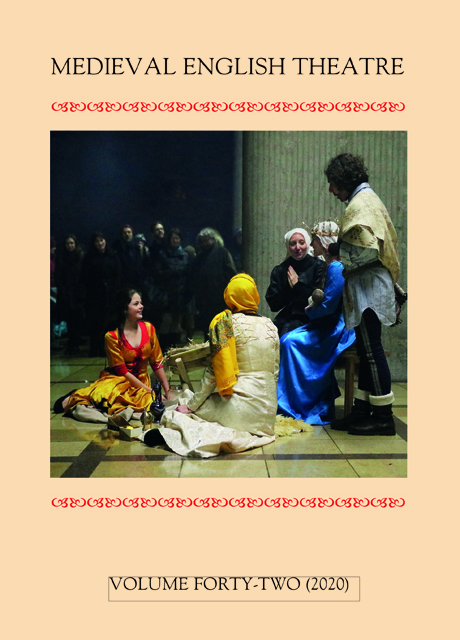Book contents
- Frontmatter
- Contents
- List of Illustrations
- List of Common Abbreviations
- Editorial
- Introduction: Reflections on the Medieval Convent Drama Project
- Fragments of Four Fourteenth-century Miracle Plays from Mont Saint-Michel
- Performing Female Authority: Convent Plays and Lay Spectatorship in the Barking Abbey Elevatio and Visitatio Sepulchri Dramatic Ceremonies
- Women in Religious Guilds: Performance and Community in Medieval and Tudor England
- When in Doubt: Thomas Indie and the Mid-sixteenth-century Reception of the Towneley Collection
- Taʿziyeh-khani in Iranian Communities: Muharram AH 1439 (AD 2017)
- Editorial Board
- Submission of Articles
Women in Religious Guilds: Performance and Community in Medieval and Tudor England
Published online by Cambridge University Press: 17 January 2023
- Frontmatter
- Contents
- List of Illustrations
- List of Common Abbreviations
- Editorial
- Introduction: Reflections on the Medieval Convent Drama Project
- Fragments of Four Fourteenth-century Miracle Plays from Mont Saint-Michel
- Performing Female Authority: Convent Plays and Lay Spectatorship in the Barking Abbey Elevatio and Visitatio Sepulchri Dramatic Ceremonies
- Women in Religious Guilds: Performance and Community in Medieval and Tudor England
- When in Doubt: Thomas Indie and the Mid-sixteenth-century Reception of the Towneley Collection
- Taʿziyeh-khani in Iranian Communities: Muharram AH 1439 (AD 2017)
- Editorial Board
- Submission of Articles
Summary
The study of local communities that accelerated with the emergence of social and local history as major disciplines in the second half of the twentieth century continues to generate major insights into the nature of society in medieval and Tudor England. As important as that research is, however, in its consideration of women and society, even the best of this first wave of foundational research concentrated mainly on the severe limitations and controls imposed on women by a patriarchal power structure, rather than on their expressive contributions to community. Even the great historian of gender and social control Barbara A. Hanawalt asserted that medieval society mainly used space to limit and constrain women as marginal beings within community. In her words, ‘women had virtually no access to the public arena in medieval times’. They ‘could not depart from a defined physical space’ without arousing suspicion. Concerning participation in entertainments, she cites a contemporary poem that declared ‘a good daughter would not go to shows like a common strumpet’. Women, she says, were ‘encouraged to preserve their private space in cities by keeping their heads down’. Nor was it a matter of class. Even in the managing of their castles ‘noble women were no more immune to spatial limitations than were peasants and serfs’. In sum, ‘medieval men consciously strove [and apparently succeeded] through a variety of mechanisms to keep women within women’s space and to regulate them within that designated area’.
A second wave of research during the 1980s and beyond into traditional culture and protest revealed the powerful voices of women in defending community during the sixteenth century and also began to illustrate the social connections between tradition and protest’s politicized use of performance (much of it involving women) to defend inherited culture. In a third wave that is flourishing now, the study of community and protest has given way to a cascade of first-rate scholarship that looks more deeply into women’s performance and patronage as an important social force within the courtly communities of England and Europe.
The wealth of archival evidence and interpretive studies that continues to emerge in current research provides an ever-more-nuanced picture of women’s contributions to society, as well as insights into the complexity and sophistication of ideas and practices that animated medieval and Tudor English communities.
- Type
- Chapter
- Information
- Medieval English Theatre 42Religious Drama and Community, pp. 90 - 114Publisher: Boydell & BrewerPrint publication year: 2021



